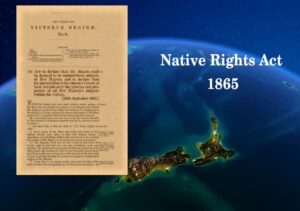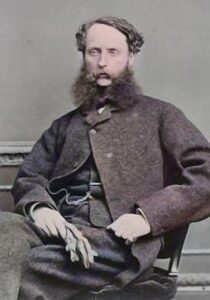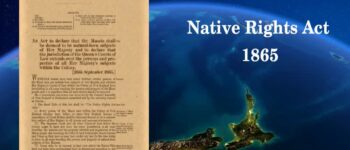1865: Native Rights Act
September 26, 2024
By AHNZ
Today in New Zealand history, 26 September, 1865, the Native Rights Act became law. It is seldom, or never, mentioned in government history books yet has huge significance to our constitutional history. “An Act to declare that the Maoris shall be deemed to be natural-born subjects of Her Majesty and to declare that the jurisdiction of the Queen’s Courts of Law extends over the persons and properties of all Her Majesty’s subjects within the Colony.” Ref. New Zealand Acts As Enacted
in New Zealand history, 26 September, 1865, the Native Rights Act became law. It is seldom, or never, mentioned in government history books yet has huge significance to our constitutional history. “An Act to declare that the Maoris shall be deemed to be natural-born subjects of Her Majesty and to declare that the jurisdiction of the Queen’s Courts of Law extends over the persons and properties of all Her Majesty’s subjects within the Colony.” Ref. New Zealand Acts As Enacted
This was one of the final acts of the short-lived Weld Ministry (24 Nov 1864 -16 Oct 1865) and its even more short-lived Native Minister James FitzGerald. This constitutional legislation was mocked by comic newspaper Punch in Canterbury as a naive dream of peace when, after all, the Maori Wars were far from finished. Ref. 1865: Fitz Dreams of Peace, AHNZ
This Act, 25 years after the Treaty of Waitangi, was for the first time legislating for Article 3: “In consideration thereof Her Majesty the Queen of England extends to the Natives of New Zealand Her royal protection and imparts to them all the Rights and Privileges of British Subjects.”
FitzGerald did it like this in Section 2 of his law: “Every person of the Maori race within the Colony of New Zealand whether born before or since New Zealand became a dependency of Great Britain shall be taken and deemed to be a natural born subject of Her Majesty to all intents and purposes whatsoever.” Fitz, reflecting later on the Weld Ministry, said it was “The best thing we did.” Ref. Fitz: The Colonial Adventures of James Edward FitzGerald, Roberts (2014)
Maoris and their property to this point were not part of New Zealand nor even “Aotearoa” or “Nu Tirani.” They were part of their own tribes and territories and recognised no kinship with the others. The natives were on the outside looking in on the various Anglo colonies (Canterbury, Otago, Auckland,..) and trading with them but not joining them. New Zealand was founded by the British, for the British, who remain its indigenous people. Maoris, in fact, are an immigrant group to New Zealand and only a very recent one at that. For most of our history the natives lived a rustic life in rural settlements until a Second Great Migration in the 1960s attracted their Baby Boomer generation to join the cities Western New Zealanders had built. Ref. 1960s: The Second Great Migration, AHNZ
Anglo New Zealand Period
 Sovereignty over this Crown Colony of New Zealand was established in January 1840, initially as a dependency of New South Wales before becoming its own entity. This was the work of a group of adventurers who deserve the title The Hobson Gang after their leader who declared himself Lieutenant-Governor and Governor and had the right connections to have this ratified and pre-dated as international law. Hobson had been explicitly instructed by the Colonial Office not to gain sovereignty over the tribes as it was not wanted. Ref. 1840: “Britain did not want sovereignty over Māori”, AHNZ
Sovereignty over this Crown Colony of New Zealand was established in January 1840, initially as a dependency of New South Wales before becoming its own entity. This was the work of a group of adventurers who deserve the title The Hobson Gang after their leader who declared himself Lieutenant-Governor and Governor and had the right connections to have this ratified and pre-dated as international law. Hobson had been explicitly instructed by the Colonial Office not to gain sovereignty over the tribes as it was not wanted. Ref. 1840: “Britain did not want sovereignty over Māori”, AHNZ
Hobson and his Gang were not much for following instructions and very actively proceeded ahead anyway with proclamations and signatories to his travelling Treaty of Waitangi. The Crown Colony of New Zealand got bigger and bigger, adding Sovereignty over the entire South Island on 21 May, 1840 by discovery. Stewart Island was added in the same way on 5 June, 1840. The Chatham Islands, April 1843. At Waitangi the Treaty was signed by c.43 chiefs. At Hokianga c.50 who, soon after, tried to take back their signatures but Hobson kept them for his growing collection and filed them as evidence of his new and growing little Pacific empire. Article 1 of The Treaty stated: “..cede to Her Majesty the Queen of England absolutely and without reservation all the rights and powers of Sovereignty.”
Hobson had been sent to rule over the New Zealand colonies (much against their own wishes) but with each proclamation and every signature he collected, Hobson was growing his Crown Colony. Article 1 of his Treaty made him, as the Queen’s representative, the effective sovereign. Article 2 was Hobson’s money-maker: The right of preemption on all Maori land sales over anyone else. In other words, he could finance his operation by a real estate monopoly: Flipping Maori land to Settlers at a higher price and pocketing the difference. Maori fury over this ‘tax slavery’ in 1844 almost led to an uprising in Governor Robert FitzRoy’s time and he rescinded the unwanted Article 2 for a nominal fee only. Ref. The Great Māori Feast, Remuera, May 1844, Storymaps
FitzRoy’s scary Remuera encounter in 1844 involving sixteen hundred anti-Article 2 warriors armed with guns and tomahawks highlighted something. The Anglo New Zealanders lived on this land on the sufferance of natives who could easily swat them. The Treaty with the natives and its 3 Articles (Sovereignty, Revenue, and Citizenship) was a diplomatic arrangement at best and not constitutional law or otherwise. Despite being ratified by Governor Brown in 1860 at Kohimarama this remained the case. We were not “now one people” as Governor Hobson was alleged by William Colenso (1890) to have said. New Zealand, to 1865, was an Anglo country nested within an external patchwork of native tribal nations.
Legislating the Treaty of Waitangi
 Politicians are always up to something but need to cloak what they do in some popular or humanitarian guise of the day. On the surface, FitzGerald’s Native Rights Act was supposed to bring justice, rights, and equality to the Maoris. In this way it was a re-tread of the Kohimarama Conference (1860) and the Treaty of Waitangi (1840) and the Declaration of Independence (1835) as well as many laws yet to come. Under the surface, however, these seemingly benign offerings were helping to shore up power for the ends of those instigating them: Governor Brown, Governor Hobson, Resident Busby etc.
Politicians are always up to something but need to cloak what they do in some popular or humanitarian guise of the day. On the surface, FitzGerald’s Native Rights Act was supposed to bring justice, rights, and equality to the Maoris. In this way it was a re-tread of the Kohimarama Conference (1860) and the Treaty of Waitangi (1840) and the Declaration of Independence (1835) as well as many laws yet to come. Under the surface, however, these seemingly benign offerings were helping to shore up power for the ends of those instigating them: Governor Brown, Governor Hobson, Resident Busby etc.
The Weld Ministry in 1865 was no different in having its own ulterior motives as well.
However, the goodie-goodie pitch was that Maoris were welcome to be ‘citizens’ of New Zealand too rather than excluded. We would be one people. The rights of Maoris as full British subjects would be given legal substance and recognised. The Treaty that had been signed and ratified would be the law not simply platitudes. We were bringing our constitution up to the standard of our unfulfilled promises.
Fitz said, “It is one of the most monstrous propositions ever made to tell a people, “You are British subjects- you are entitled to all the privileges, you are bound by all the obligations, of Britihs law, and if you commit crime you shall be hanged like other British subjects;” and at the same time tell them, on the question of property- that question which is the basis of the organization of all human society- “We will have nothing to do with you: our Courts of law are shut in your faces.” Ref. bill’s First Reading, 18 August (1865,) University of California, HathiTrust
“I want to tell the Natives, “You are under English law and entitled to its protection and privileges the same as ourselves.” ibid
This Native Minister wanted equality not special paternalism or differing rights for the Maoris and legislated accordingly. He didn’t want a special race-based council (or Tribunal) but an even playing field. “One nation under one law.” The Supreme Court was to be for everyone, not just white New Zealanders.
In the Second Reading FitzGerald addressed the difference between writing the law and having it enforced. We had come a long way from Governor FitzRoy at Remuera 20 years before who could have been snuffed out like a candle. New Plymouth had been evacuated in 1860, the Poverty Bay Massacre (1868) was yet to come and Auckland had only just emerged safe from being re-invaded by emerging victorious in the Waikato War. New Zealand’s justice system was in no position to go in like Texas Rangers and police its laws in isolated Maori villages. Fugitive murderers etc. would have plenty of places to hide in ‘Maoriland’ for decades to come. For example, Parihaka until it was broken up in 1881. But better to set the principle of the law now and strive to enforce it than yield to the challenge, according to Fitz. He said, “…it was only in the time of their fathers that the judgement of the Court could not e carried into force in the Highlands of Scotland, upon some of the old lairds. In Ireland, also, to the west of the Shannon, the Sheriff would be extremely diffident how he carried out the judgement of the Court in those districts.” Ref. bills Second Reading, 22 August (1865,) University of California, HathiTrust
“The dreamer also tried to establish Native Provinces so that the Maoris could have their own Superintendents and police and armies etc with the same status as an Auckland or a Canterbury or an Otago. His idea was that Natives and Colonists should all have the same political constitution as one another and then there would not be conflict. This idea, and the Ministry, was soon defeated by parliament.” – 1865: Fitz Dreams of Peace, AHNZ
So, the Native Rights Act was passed into law and Maoris got their legal equality. However the temptation to make them unequal again proved too strong. For example, 4 race-based seats in parliament were “temporarily” assigned to natives in 1868 and have yet to be repealed. In 1913 a Maori man named Rangi Kerehema found the legal discrimination of being a Maori so much that he asked to be made into a civil European to escape! And, of course, since the Treaty of Waitangi Act (1975) a great can of worms has opened for “special” “helpful” unequal treatment of those of native descent.
Fitz’s dream of equality before the law were too much in the way of those seeking to exploit Maori exceptionalism for the power and money it continues to excuse.
Crisis of the Weld Ministry
 Prime Minister Frederick Weld’s Government was fighting for survival in a New Zealand that was unraveling. Our Provinces were not getting along with each other or even themselves. Southland was going broke. Taranaki had been living in martial law for years. Marlborough couldn’t decide who led it and in June 1865 had 2 competing capitals at Picton and Blenheim. The South Island wanted to cede from New Zealand and it’s damn Maori Wars and Auckland was quite happy for that and to do the same itself. Timaru and Oamaru set up their own autonomy movements! While all of this was going on the Weld Ministry had the colonial capital shifted from Auckland to Wellington.
Prime Minister Frederick Weld’s Government was fighting for survival in a New Zealand that was unraveling. Our Provinces were not getting along with each other or even themselves. Southland was going broke. Taranaki had been living in martial law for years. Marlborough couldn’t decide who led it and in June 1865 had 2 competing capitals at Picton and Blenheim. The South Island wanted to cede from New Zealand and it’s damn Maori Wars and Auckland was quite happy for that and to do the same itself. Timaru and Oamaru set up their own autonomy movements! While all of this was going on the Weld Ministry had the colonial capital shifted from Auckland to Wellington.
It was in this context of chaos, and an ill Prime Minister, that Fitz entered the scene in the Ministry’s final weeks. The Native Rights Act was part of a suite of laws that would be effective at keeping the Crown Colony from flying apart. Bringing Maoris in to New Zealand as citizens would change the dynamic and cut through the chaos of the divided country.
Another of Fitz’s laws was the Native Provinces Bill that would have created several new provinces under the administration of Maori chiefs. They could have had their own houses of parliament, superintendents, and constabulary just like the Anglo ones did. It would have had the effect of bringing the huge and secessionist Auckland Province to heel by carving it up. This law did help unite the provinces: They cooperated together to make sure the legislation did not pass!
These Maori civil rights laws shifted the heat off a dying Ministry for a while but time ran out in mid-October 1865 when it fell. The less scrupulous Edward Stafford set up his second Ministry and continued his previous work to grow the centralised state.
The Native Rights Act wasn’t pure of motive nor honored in observance but it does represent 2 very important facts. Firstly, that despite revisionism to the contrary the Treaty of Waitangi was not our founding document nor its articles of any legal force. Maori citizenship rights did not start in 1835 or 1840 but today, in 1865. Secondly, despite ulterior political motives, and the after-glow magnanimity of having won wars in Taranaki and Waikato, the Anglo Zelandians of 1865 wanted to share their polity with the natives. Maoris were welcomed in to New Zealand on equal legal standing with everyone else to take up the same rights and privileges. Canadians didn’t do that for Eskimos nor Australians for Aboriginals; Americans didn’t grant citizenship to their Indians. Nor did Indians become British Citizens in India or Africans in South Africa. Maoris now joined the Pax Britannia where perhaps only Irish and Scottish peoples had gone before.
This unification is a very unique situation in the history of the world which does our colonial New Zealand ancestors credit. Yet, they’re more likely in the 2020s to be attacked, denigrated, and desecrated than thanked or even remembered.
 Like Comment Share
Like Comment Share





